
Regardless of how you feel about listicles, you’ve probably read a number of them. Listicles help present a large amount of information in small, easy-to-scan, numbered sections.
List posts can cover all kinds of topics, from the more educational posts on HubSpot like “How to Create a Cinemagraph in 7 Easy Steps” to the clickbaity Buzzfeed lists like “23 People You Seriously Won’t Believe Actually Exist.”
In this article, I’ll guide you through six steps to create an effective list post.
I’ll also explain why these posts are so popular and why they are critical to a successful content marketing strategy.
What is a Listicle?
Simply put, it’s an article made up of a list of items or ideas.
Despite what you might think, Buzzfeed didn’t invent listicle content. It’s been around for centuries.
Sei Shonagon, an 11th-century Japanese poet and lady-in-waiting, is believed to have penned the first listicle, which included gems like her list of “Rare things” such as “Two people living together who continue to be overawed by each other’s excellence.”
That being said, Buzzfeed has indeed popularized listicles as online content.

For content creators and marketers, listicles are a convenient way of presenting information in bite-size portions. Producing the content becomes a bit easier, and consuming it more enjoyable.
Why are Listicles So Popular?
Imagine coming across the following two topics during a Google search:
- 11 Effective Email Marketing Tips
- How to Do Email Marketing
Which of the two are you more likely to click? The first one, right? By specifying a fixed number of tips, the first topic promises easy-to-skim content.
With the average human attention span down to about eight seconds, it’s harder to pay attention to one thing for very long. An article that allows readers to skim is far more appealing.
From the first title above, readers also know what to expect within the article. They know there are just 11 tips, while the other one might be five tips or 50 pages of how to write, launch, and optimize their email marketing.
Listicle content structure, on the other hand, is quite simple. Typically there’s an introduction, a list of ideas, and a conclusion. This makes listicle production relatively easy compared to other types of posts.
Listicles are also popular because they feed into our brain’s drive to categorize information and give us a sense of satisfaction when we correctly predict patterns.
Marketers love listicles because they get clicks. According to a recent study, 36% of readers prefer titles with numbers over any other title type.
How to Use Listicles in Your Content Marketing
Because listicles have had a poor reputation, you might be hesitant to use them in your content marketing strategy. The truth is, listicles can be as helpful and informative as prose, provided the content is high quality.
For example, I created this listicle about how to use TikTok in marketing. It is in a listicle format, but still offers valuable information marketers can use to drive traffic and increase brand awareness.
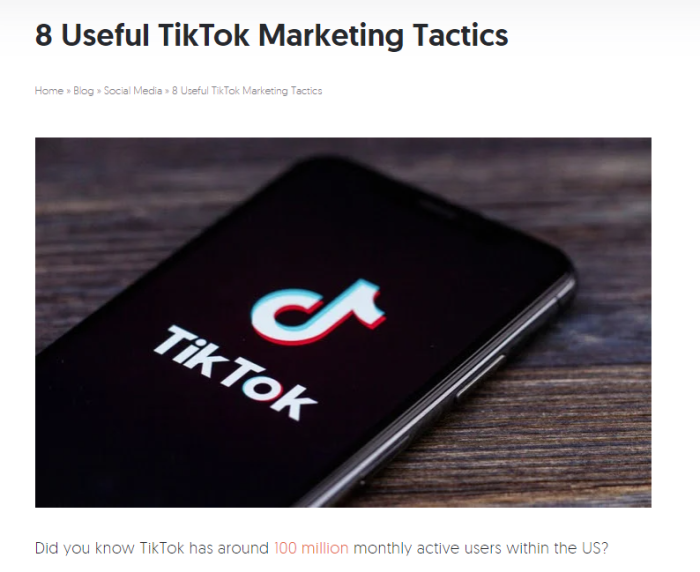
Content marketing’s purpose is to attract and retain readers. Listicles can help you achieve this goal and build an effective content marketing strategy.
Here are a few ways to leverage listicles’ power to drive clicks, traffic, and build brand awareness.
- Make a complex topic easy to understand by breaking it down into manageable parts, such as “Six Things Everyone Should Know About Quantum Physics.”
- Create a step-by-step guide about a topic. (Like I am doing here.)
- Share a unique angle about a popular topic, like “27 Awesome Ways of Repurposing Content,” which goes beyond the standard advice of turning a blog post into a podcast or create an ebook out of several listicles.
- Compare tools or suggestions, such as “10 Online Marketing Tools You Need When Starting a Business.”
Listicles can also be used as lead magnets to grow your email list, to share expert advice, or as a way to expand your brand’s social media presence.
How to Write a Listicle in 6 Steps
Now that you understand the power of listicles, let’s cover how to write an effective one that will drive traffic.
1. Pick the Right Listicle Topic
This is crucial. If the topic you pick doesn’t fit a list format, it won’t earn as many clicks.
Some topics naturally fit into a list. For example, how-to guides can be broken down into distinct steps:
Blog posts consisting of a list of examples make great listicles:
What if your content is a narrative? Can you produce a listicle from that?
You’d have to be pretty creative to write a narrative as a listicle since it doesn’t lend itself to that style of writing. That said, it’s not impossible.
Take this article “Long read: The World’s Most Successful Alliance — 70 years of freedom.” It tells the story of the North Atlantic Treaty Organization (NATO) by listing “… the 9 biggest moments in NATO’s history.”
Another way to determine whether your topic can be a listicle is by doing a simple Google search of your target keyword.
Suppose a number of the high-ranking articles for your keyword are listicles. In that case, it’s a good indication that searchers expect or prefer a list format to tackle the topic:
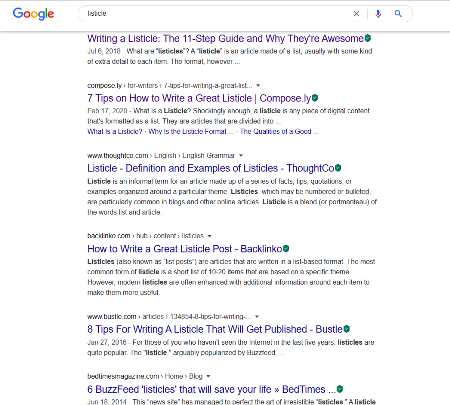
Another good place to look is your own Google Analytics data. If you see that a specific topic gets a ton of traffic, then it might do well as a listicle if you can easily simplify the content.
For example, I know that the listicle topic gets 6,600 searches a month, according to Ubersuggest. Since it’s already a popular topic, it might be a great choice to create a listicle around.
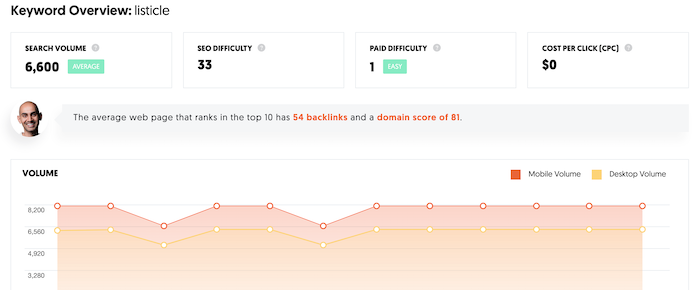
2. Do Your Keyword Research
If the reason you’re so keen on creating a listicle is to boost your content marketing, keyword research has to be on your to-do list.
Keywords are the terms searchers type into a search engine to get information on a particular topic. They’re also the words Google and other search engines use to identify your blog post’s or web page’s focus.
When you optimize your content for particular keywords, your page is more likely to rank and appear as an option when people search for those terms.
You can use free tools to do keyword research such as Google Keyword Planner or my own Ubersuggest.
While you’re at it, look out for long-tail keywords, because listicles are perfect for targeting these valuable terms.
3. Outline Your Listicle Content Points
So far, you’ve chosen your topic and target keyword. Now let’s get into the listicle content.
Start by checking out your competition. You’ll most likely notice a few common topics. Look for any weaknesses or gaps in your competitors’ content.
For example, while creating this listicle, I took a look at what’s already been written about listicles:
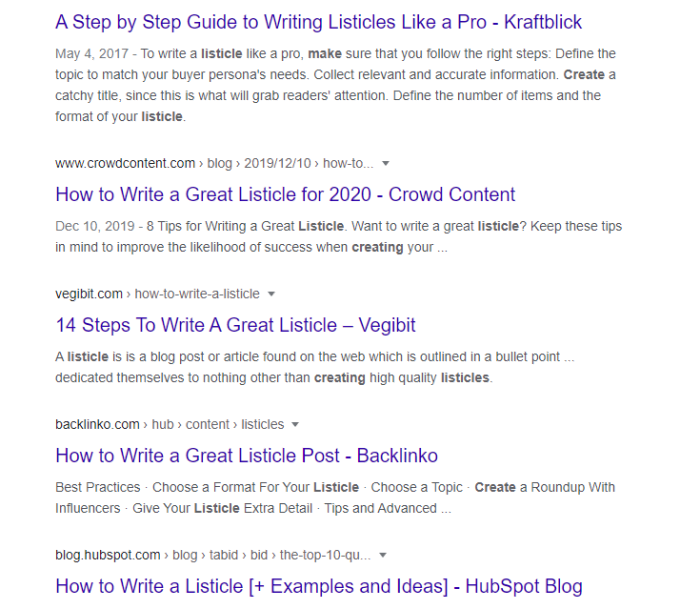
There are tons of articles about how to write a listicle, but only one in the search results above is a listicle itself, and we already know that listicles get more clicks. That means there’s an opportunity for me to create better content than what everyone else has already published.
Next, brainstorm and jot down any points you think would be relevant to your listicle. Then go through all the points you’ve written down. If they would be presented best in a particular order, organize them accordingly, and merge any redundant points. Split up any items that may be too weighty for just one point and try to make them multiple points.
Look at “People also ask” questions in Google. These are questions that people commonly search about the same topic. They’re an easy way to make sure you’re covering the topic thoroughly.
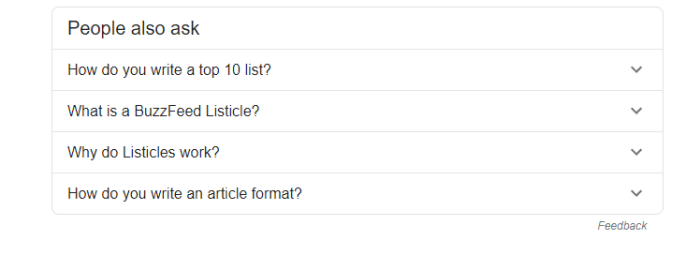
Flesh out each post by adding examples that show why each item in your numbered list was included or how to do it if you are creating a step-by-step guide. For example, this listicle on HelloBar about lead magnets provides an example of different lead magnets and talks about why they work.
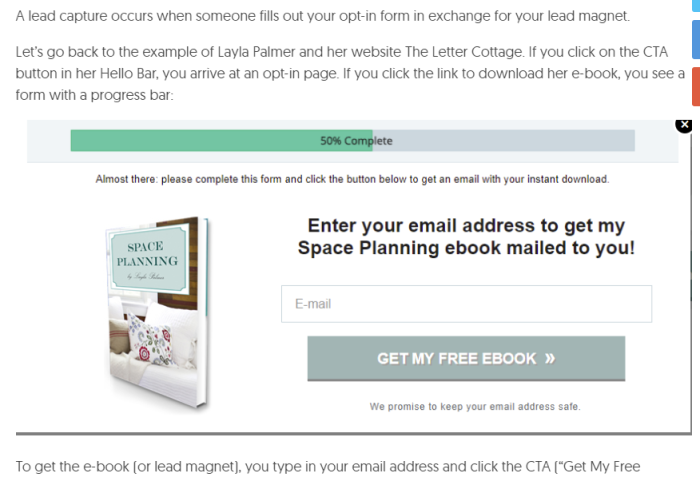
As you write your content, link to more in-depth information when necessary, but make sure you don’t link to posts trying to rank for the same keywords. This creates more informative content without making your article too long.
4. Number the List Items
You don’t have to use lists to create a listicle, but it creates a better user experience. As readers go through the article, moving down the numbered list creates a sense of progress. There’s also a feeling of accomplishment, which motivates readers to keep reading. It also makes sense to number the items if you use a number in the post title.
For lengthy list posts, numbers can make it easier for readers to keep track of their progress. They can even stop reading and easily pick up later where they left off.
Numbering is also helpful when someone wants to share or reference specific points. It’s easier to refer to a particular number rather than describing a section in the article.
How many points should you use though? A round number like 10 is easy to remember, but odd numbers are more eye-catching and tend to pique the reader’s interest.
The reality is, there’s no right or wrong number to include in your listicle; it depends on the topic and your competition.
If all the other posts are 10 points long, it might be good to have even more, like 25 or even 30. On the other hand, if most other listicles in your niche are really long, a short, snappy post might do well.
Whatever route you go, aim to grab readers’ attention by standing out.
5. Add Interesting Images
It’s challenging to sustain readers’ attention with just a wall of text, numbered or not. Images make your content more visually stimulating, making them an essential ingredient in successful listicles. They improve the posts’ readability and help to increase traffic.
Images or gifs capture readers’ attention in a way plain text can’t. For example, people follow instructions that include images 323% better than written words alone. Articles with relevant images get 94% more views than those without images.
Buzzfeed makes excellent use of this tactic. Most of their posts include numerous images. You just can’t help but scroll on to view one after the other.
Ensure the images you select are relevant to the post. Filling your posts with unnecessary images adds no value and may result in a higher bounce rate.
When choosing images to add to your listicle, custom photos are ideal. For example, if your article involves reviewing products, you can include pictures of those products. This Digital Trends article about the best desktop computers includes custom images of the computers, which establishes trust in the content because it shows they’ve actually tried the computers.

If custom photos aren’t possible, you can find free images online on Pixabay, Unsplash, and Flickr, among others.
6. Avoid Listicle Content Clickbait Titles That Don’t Deliver
I know this may seem contradictory since I wrote another post about creating clickbait headlines. Before you pounce on my controversial statement, let’s make this clear: clickbait isn’t inherently bad.
Crappy titles that promise but don’t deliver will drive users away. Intriguing titles that pique curiosity and drive clicks are powerful.
Does your listicle’s title promise something you don’t deliver in the body of the article? Are the claims in the headline unrealistic or untrue?
If the honest answer to either of these questions is “yes,” your title is most likely the decried clickbait headline, and you may want to avoid it. Listicles have a bad reputation for being clickbait.
Sensational titles may mislead readers, spoil your blog’s reputation, and hurt your content marketing in the long run. Great headlines that deliver what they promise can effectively attract readers.
On average, eight out of ten people will read your title, but only two will read the rest of your copy. This statistic proves the importance of headlines in converting page browsers to readers.
Conclusion
New content marketing strategies crop up every day. The only constant is high-quality content. Smart digital marketers understand the importance of high-quality content that’s optimized for search engines and valuable to readers.
No matter the format, great content can help generate search traffic and leads. List posts can offer the best of both worlds: easy-to-write structure and quality content that turns browsers into readers.
Have you written any listicles recently? Do you take any other steps to produce list posts?
The post The 6 Step Guide to Writing Listicle Content appeared first on Neil Patel.
from Blog – Neil Patel https://ift.tt/2SSTVr7

No comments:
Post a Comment